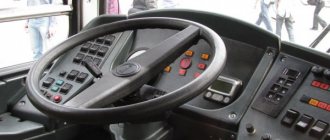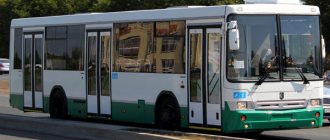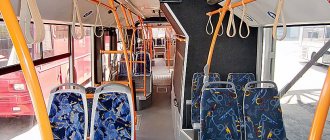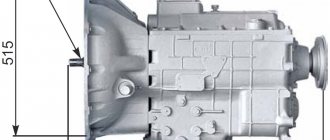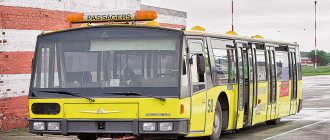The MAZ-203 bus is a low-floor modern bus that runs on city and suburban routes. The spacious interior of the vehicle allows it to carry a large number of passengers. A convenient, comfortable car is in demand both in the country of origin and outside the state.
The article presents photos of the car that clearly demonstrate what the bus looks like outside and inside.
Design Features
It is noteworthy that the Minsk bus uses a Mercedes-Benz OM906LA engine that complies with Euro 4 and 5 environmental standards. The engine is installed at the rear of the car in the engine cabinet. Its operation is checked by an on-board computer that supports GPS and GSM. The vehicle can reach speeds of up to 100 km/h, but usually the top speed is 75 km/h.
The bus is also equipped with other imported components, which has a positive effect on the characteristics of the vehicle.
Interior arrangement
On the left side of the podium there are three double seats. The tilt of the backrests complies with ergonomic standards. At the rear wall there is one continuous row of seats for six people. The total number of seats is 32.
The floor of the MAZ-203 model is flat throughout the entire cabin, but at the very end there is a small raised platform on which three seats are located. A module with chilled drinking water is installed in the rear left corner. There are two more seats in front of the machine. Eight seats are mounted on the wheel arches of the rear wheels, four on each side. These seats are installed with their backs facing each other. For some passengers who get motion sickness on the bus, this reverse position works best. The remaining seats are installed in the usual order, in the direction of travel. However, on the front wheel arches the seats are also turned with their backs facing each other.
Driver's workplace
The driver's cabin has a comfortable seat equipped with air suspension.
The photo shows the driver's seat
This allows you to adjust the tilt, height of the seat, move it forward or backward. A distinctive feature of the seat in this bus is that you can adjust the heating, rigidity, lumbar support, and armrests on both sides.
The cabin has a stylish operating panel with a liquid crystal display. It is distinguished by a convenient location of the keys - next to each other there are buttons for opening all doors and sound notification of the interior.
The only thing that doesn't fit into the modern cabin design is the steering wheel and switches.
There is a feeling that they are left over from an old vehicle from the times of the Soviet Union.
The cabin heating is arranged as in passenger cars - the cabin and windshield are heated by one device.
Model features
The MAZ-203 is significantly more expensive than its predecessors from the first generation, but this does not prevent it from being much cheaper than European brands. The bus was created using the latest technologies, and also has foreign-made components and assemblies in its design, which makes it technically reliable.
If we compare the MAZ-203 with buses from the first generation, it is worth noting the following distinctive features:
- low floor level;
- modern design;
- modified transmission and chassis;
- lots of additional equipment.
Advantages and disadvantages
The city and suburban bus MAZ-203 has the following advantages:
- stylish design;
- panoramic windshield;
- good visibility of mirrors;
- spacious interior;
- a large number of seats and a large capacity of the car;
- convenient location of stationary validators;
- in the autumn-winter period the cabin is always warm;
- wide doors allow passengers to enter the cabin on one side and leave it on the other, which reduces the time spent at stops;
- low floor;
- wide windows allow you to ventilate the interior in hot weather;
- the car starts, stops and drives smoothly, which prevents citizens from getting motion sickness;
- comfortable, adjustable driver's seat;
- warm cabin;
- Availability of air conditioning in the cabin.
Disadvantages of the vehicle:
- noisy engine operation;
- lack of a separate entrance for the driver and a partition separating the cabin from the cabin;
- small route indicator on the front of the vehicle;
- cramped cabin;
- lack of adjustment of air flow to the windshield and into the driver's cabin.
According to experts, the main drawback of the vehicle is the lack of a separate entrance for the driver and a partition separating the cabin from the passenger compartment.
As a result, passengers occupy the free space on the right side of the cabin. This has a negative impact on traffic safety, since citizens cover their windows and rearview mirror, which impairs the driver’s visibility. At the same time, various kinds of barrier elements in the form of a rope or chain are prohibited in the cabin. The citizens themselves, for the most part, ignore the warning signs and the words of the conductor that they are not allowed to enter the cabin. This is how drivers have to drive during rush hour with poor visibility on the right side.
Photo of the bus interior
Boarding and disembarking
The interior space of the MAZ-203 model looks quite spacious; in the area of the middle doors there is a free area that can accommodate a wheelchair user or several suitcases. For boarding and disembarking disabled people, a retractable platform is provided, which is equipped with an electric drive and controlled from the driver’s cabin.
The height from the road surface to the floor line is 330 mm, this is enough for ordinary passengers to get on and off comfortably, despite the fact that the bus is parked at the curb, which is at every stop along the route. The car approaches strictly along the line, with the expectation that all three doors end up right at the edge of the asphalt area. Its height is 18-20 centimeters.
Specifications
Technical characteristics of the MAZ-203 bus:
- number of seats in the cabin – from 24 to 39;
- total vehicle capacity – from 86 to 105 people;
- length – 12000 mm;
- width – 2550 mm;
- height – 3200-3400 mm;
- maximum permissible weight – 18000 kg;
- maximum speed – 75-106 km/h;
- outer turning radius – 12500 mm;
- base – 5900 mm;
- wheel formula – 4*2;
- braking system – pneumatic with ABS and ASR;
- gearbox – automatic.
The MAZ-203 bus is a comfortable vehicle with a comfortable, spacious interior and a low floor, which allows citizens to easily climb into the cabin and go outside. The vehicle has both advantages and disadvantages, which must be taken into account when buying a car. In Russia, the price of such a machine is approximately 8,000,000 rubles.
Review of the LiAZ 5256 bus.
Views: 7,952
Reliability and safety
To summarize, I would like to say that transport is one of the safest means of transportation, and it is also capable of affecting a considerable number of people. In addition, the attractive design can turn an ordinary trip into a more enjoyable one, and there is more than enough comfort here.
It is safe to say that the MAZ 203 bus is a reliable vehicle to operate. In the most severe frosts it is comfortable to be in it, and in the summer it will never be stuffy or hot.
Location of electrical equipment on the roof.
1 - power supply unit; 2 — automatic switch of the traction drive; 3 - block of contactors; 4 — block of braking resistors; 5 — block of braking and damping resistors; 6 — traction converter of an asynchronous motor; 7 - compressor static converter; 8 — block of noise suppression reactors; 9 — “Point 1” leakage current measurement; 10 — autonomous battery charging converter.
- Basic characteristics of electrical equipment.
- Installation of the traction motor.
The trolleybus is equipped with an AC traction motor of the DTA-1 U1 type. It is located in the rear overhang on the left side of the trolleybus.
Trolleybus mechanical equipment
- Rear (drive) axle.
The trolleybus is equipped with a ZF AV-132/80 portal drive axle. Maintain the drive axle in accordance with the “Regulations for lubrication and maintenance of the drive axle ZF AV-132/80”. Lubricant quality and lubricant change intervals according to the “List of Lubricants TE-ML 12”. The oil quantity and class are indicated on plate 2 attached to the bridge.
- Front (driven) axle).
The front axle ZF RL-85 A is installed on the trolleybus. Maintenance of the front axle is carried out in accordance with the “Regulations for the lubrication and maintenance of ZF front axles”. To lubricate pin and wheel bearings, use lithium grease NLGI class 2 (grease designation KP2K-30 according to DIN 51825 or ISO-L-XCCHB2 according to ISO 6743-9).
- Driver's seat
The driver's seat is equipped with an air suspension that automatically maintains a set height regardless of the driver's weight. Depending on the configuration, the trolleybus can be equipped with seats from different manufacturers:
— Driver’s seat OJSC MAZ
— Driver's seat from ISRI
- Steering
The trolleybus is equipped with hydraulic power steering, which ensures ease of control, the necessary rotation of the wheels and their return to the neutral position. It includes the following components:
— General steering diagram
— Adjustable steering column
— Angular gearbox
— Steering rods
— Hydraulic power steering
— Oil filter FR110-C25 B3 0 R1
Design
A modern bus attracts attention with panoramic glass. Installed mirrors increase visibility of the road.
The model has a load-bearing body made of galvanized pipes.
Transport dimensions:
- 12 m long;
- 2.50 m wide;
- 2.80 m high;
- 18 tons weight (6.5 tons on the front axle and 11.5 tons on the end axle).
The machine has a low floor level – 340 mm. from the road surface, which makes it more comfortable for passengers to board.
Wide doors allow you to freely bring in a baby stroller and other large items.
Design
The body parameters are the same for all second-generation MAZ city buses. These are models MAZ 256, 171, 251, 206. The body frame is made of profile galvanized thin-walled pipes. The welded structure is connected to the fiberglass sheathing panels, after which the glass is inserted into the grooves.
The panoramic windshield provides the driver with full visibility and also contributes to effective interior lighting. The front door is fully operational for passengers to enter and exit, while on the MAZ-103 model only one door worked for this purpose - the other served to allow the driver to enter the cabin.
Export
According to its data, the MAZ-203 complies with the standards of European countries and has already been exported to Germany and Poland. The issue of supplying the bus to Spain is currently being considered. Urban transport in this country mainly consists of similar buses, so the two hundred and third will fit well into the transport structure of Madrid and other large cities.
The bus is a laureate of the 9th Moscow International Motor Show "Motor Show 2005". The car also received first place at the international exhibition SIA-2006, held in Kyiv.
Trolleybus electrical equipment
- Installation of electrical equipment.
1 — climate control system for the driver’s cabin; 2 — block of automatic auxiliary switches; 3 - block of contactors; 4 - harnesses; 5 - compressor; 6 — traction motor; 7 - pumping hydraulic station; 8 — pneumatic system sensors; 9 — fog lights with daytime running lights function; 10 — low beam headlight; 11 — high beam headlight; 12 — direction indicator; 13 — windshield wiper; 14, 17, 20 — information board; 15 — front side lights; 16 — rear marker lights; 18 — rear lights; 19 — roof container; 21, 25, 28 — batteries; 22, 23, 24, 26, 27 — interior heater; 29 — instrument panel; 30 — driver’s workplace heater.
